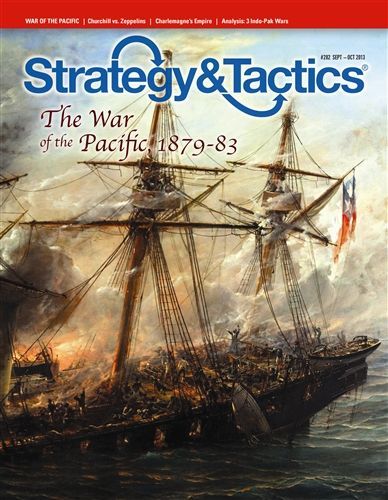War of the Pacific, Chile vs. Perú and Bolivia, 1879-1883 (2013) Board Game
Brief History and Background Information
The War of the Pacific, also known as the Saltpeter War, was fought between Chile and a Bolivian-Peruvian alliance from 1879 to 1883. The root of the conflict was a dispute over control of valuable nitrate-rich desert territories in the Atacama region. The war resulted in Chile’s victory and significant territorial gains at the expense of Bolivia and Peru.
Game Components of War of the Pacific, Chile vs. Perú and Bolivia, 1879-1883
- Detailed game board depicting the South American theater of war
- Player pieces representing the armies of Chile, Peru, and Bolivia
- Dice for resolving combat and other actions
- Rulebook outlining gameplay mechanics and historical context
- Counters to track units and resources
How To Setup War of the Pacific, Chile vs. Perú and Bolivia, 1879-1883
- Unfold and set up the game board on a flat surface.
- Place the player pieces in their starting positions according to the rulebook.
- Distribute counters and other components to each player.
- Roll to determine the starting player.
Gameplay Mechanics and Game Objective
Players take turns moving their armies, engaging in battles, and strategically managing resources to achieve victory. The game simulates the historical events of the war, allowing players to make decisions that could alter the course of history. The objective is to control key territories and defeat your opponents to secure victory.
Player Experience
Pros:
- Engaging historical theme that educates players about a lesser-known conflict
- Strategic depth and replay value for those interested in wargaming
- Detailed components and artwork that enhance immersion
Cons:
- Steep learning curve for beginners due to complex rules and mechanics
- Lengthy runtime may deter casual players looking for a quick game
- Limited player count of 1-3 may restrict group play opportunities
Personal Thoughts on War of the Pacific, Chile vs. Perú and Bolivia, 1879-1883
War of the Pacific offers a deep dive into a historical conflict rarely explored in board games. The game’s components are well-made, capturing the essence of the era. However, the game’s complexity may be daunting for newcomers to the wargaming genre. The pricing and availability of the game may vary, but it offers a unique experience for history buffs and strategy enthusiasts. It is worth considering for players who enjoy in-depth simulations and historical context in their gaming experience. Those looking for a lighter, more accessible game may want to skip this one.
Game Components of War of the Pacific, Chile vs. Perú and Bolivia, 1879-1883
How To Setup War of the Pacific, Chile vs. Perú and Bolivia, 1879-1883
Setup involves placing the map and distributing the counters according to the initial deployment rules. Each game turn represents approximately two months of real time, and the game is divided into twelve turns. Players need to align their units and resources with the historical context of the war, focusing on the conventional and guerrilla phases.
Gameplay Mechanics and Game Objective
Player Experience
This game offers a deep dive into the historical conflict between Chile, Peru, and Bolivia, providing players with a detailed simulation of the war’s dynamics. Players can experience the strategic challenges faced by the historical commanders and understand the complexities of the war. The game’s low-complexity design makes it accessible to new wargamers while still offering enough depth for experienced players.
Pros
Cons
Personal Thoughts on War of the Pacific, Chile vs. Perú and Bolivia, 1879-1883
This game is ideal for history buffs and wargamers interested in the 19th-century conflicts in South America. It provides a unique perspective on the war, allowing players to understand the strategic and tactical decisions made during this period. For those new to wargames, it serves as a good introduction due to its relatively low complexity. However, it may not appeal to those seeking fast-paced or highly abstract games.
We are supported by our audience. When you purchase through links on our site, we may earn an affiliate commission, at no extra cost for you. Learn more.

